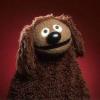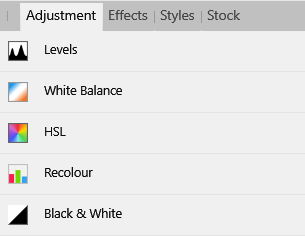-
Posts
3,560 -
Joined
-
Last visited
Everything posted by toltec
-
OK, I admit it. I was bored and poking around On the iPad Photo version, why can you not add presets on the Channel Mixer or Selective Colour adjustments? You can add presets for them in the desktop version, but there is no Add button on the Context Toolbar for the iPad version. 1.6.9.81 I am minus a plus.
-

A better way to select underneath layers?
toltec replied to Xebius's topic in Pre-V2 Archive of Affinity on iPad Questions
Hi Manuel As you talking about illustrations, I assume you are using Affinity Designer, although you also mention PS (Photoshop) the equivalent of which is Affinity Photo. Following on from what @DM1said, it would be worth experimenting with Outline view (Affinity Designer only). That makes it easier to select objects because you can see the hidden layers, and target them more easily by tapping on their outlines. If you set up Split View (Navigator Studio) you can 'switch' between Outline View and normal Vector view just by dragging the slider from left to right. Hope that helps. -

Text to Outline
toltec replied to badgenes's topic in Pre-V2 Archive of Affinity on Desktop Questions (macOS and Windows)
Convert to Curves on the Toolbar Layer menu > Convert to Curves, or use the keyboard shortcut Ctrl + Return -
I have the same problem sometimes with my convertible PC/tablet touch screen I use the glove that came with my graphics tablet. They are cheap enough from Ebay and are very light and comfortable to wear. Search for 'anti-fouling glove' or 'tablet glove'. or you use a thin glove and a pair of scissors. That's a snip
-

Affinity Designer
toltec replied to Ranju Mathew's topic in Pre-V2 Archive of Affinity on iPad Questions
Hi Ranju If you are thinking of buying it, I think it's worth the money but it depends what you want it for. It's better for creating David Hockney type artwork. Photo is better for editing photos. There are a few useful extras for creating artwork. There is the Pencil Tool which allows you to draw and sculpt (redraw) lines in a freehand way. The Vector Brush Tool for painting and later editing brush strokes. The brushes are actually pixel brushes, but you can change the shape of the path later. The Corner Tool lets you round-off corners (plus different shapes) The Transparency Tool gives several creative effects when applying transparency. You can put text on a path, on a shape and so forth. The Assets Studio is good to store and quickly put design elements on a page Symbols means that if you create one object and use it several times, you can edit one object, and all copies of it will change. Artboards allows multi pages on screen at a time. There are a few more options, but less useful perhaps for a casual user. -
Almost. I was taught to always do sharpening last. Unsharp mask effectively put a fringe around the edges and the amount (radius) is important. If you then go resizing the image, defringing the image or dodging and burning, you affect the unsharp mask edge, reducing or increasing it, Not to mention "artefacts are us"!
-
What you need to do is work out how many pixels are required to display on your web page. For half of a 1920 pixel page, you need 960 pixels. That's it, do as Alfred says and ignore PPI, DPI LPI etc. The only thing that matters is the quantity of pixels in the image. Because of the different devices and different resolutions, a display of a 920 pixel image will vary in physical size dramatically. So you just can't use physical dimensions for anything. For litho printing, you need about double the amount of pixels in an inch relative to the lines per inch value of the printer. Most colour printing is done with 150 or 175 lines per inch, so 300 or 350 pixels per inch. But as I said, that will be probably be produced on a 2540 dots per inch imagesetter. You can certainly use higher numbers of pixels per inch but the file sizes will be bigger. That's the only drawback.
-
I was in the print trade for 30 years and I have never seen that and are you talking about pixels, lines or dots per inch. The trouble is, most people don't seem to understand this. For what it's worth the imagesetter I used in the print trade was 2540 dots per inch, even although it was normally used to produce film for 150 lines per inch from 300 pixels-per-inch images. And take pixels (the reason for my question) on a 52 inch TV, with an HDMI screen, there are about 36 pixels in an inch. On some iPads there are over 300 pixels in an inch. So, to repeat myself, how big is a pixel ?
-
Hi @Annenigma What does happen? Sorry if you have already done the following --- If I press the + on the Home screen to open a file, then tap Import from Photos, I get this If you see nothing, go to the iPad home screen and check the Settings app and scroll down on the left until you find Designer Is Photos set to Read and Write ?
- 10 replies
-
- permissions
- requests
-
(and 1 more)
Tagged with:
-

Advice welcomed.
toltec replied to Jaykay's topic in Pre-V2 Archive of Affinity on Desktop Questions (macOS and Windows)
Hi @Jaykay Welcome to the forum. Quite a lot of Affinity stuff is done using a Macintosh. It will therefore look a bit different on a Windows PC, which I assume is what you are using. This is how Levels looks on a PC, with both dark or light interfaces. It is always a good idea to state what OS you are using when asking a question because there are a few differences. As you have just found out. -
One problem is, you have a small pixel layer floating inside a large empty transparent layer. Don't know why or how. Would it help if you use Edit > Matte and fill the background of the layer with the green ? Maybe you could incorporate that in your macro somehow ? What actually do you do with the layer after outlining it ?
-

node along an edge
toltec replied to claycle's topic in Pre-V2 Archive of Affinity on Desktop Questions (macOS and Windows)
It must be If I have ants, I can make a duplicate copy of the selection area and pixels with any tool selected, selection tools or even the Magnifier tool. -
To be honest, you just need to make a better selection. Designer does it well enough. I did this in Designer. Photo is better if the green is showing through hair or is reflecting off skin. Edit: Oops, forgot to say if you post the original with the green screen but without all that chequerboard I'm sure someone will try and advise a bit better.

























